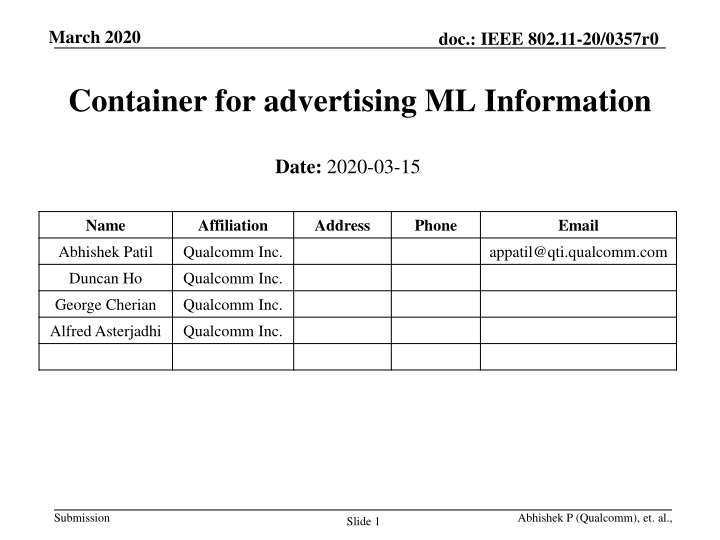Framework for Advertising Multiple-Link Operations in IEEE 802.11
Proposed framework for advertising Multiple-Link Operations (MLO) capabilities in IEEE 802.11 networks classified into three categories: Common MLD Information, Per-Link Information, and Multiple BSSID features. Introduces a new element, Multiple Link Attribute (MLA) element, with profiles for each link to avoid duplication of information. The framework aims to enhance the efficiency and effectiveness of multi-link communication in wireless networks.
Download Presentation

Please find below an Image/Link to download the presentation.
The content on the website is provided AS IS for your information and personal use only. It may not be sold, licensed, or shared on other websites without obtaining consent from the author.If you encounter any issues during the download, it is possible that the publisher has removed the file from their server.
You are allowed to download the files provided on this website for personal or commercial use, subject to the condition that they are used lawfully. All files are the property of their respective owners.
The content on the website is provided AS IS for your information and personal use only. It may not be sold, licensed, or shared on other websites without obtaining consent from the author.
E N D
Presentation Transcript
March 2020 doc.: IEEE 802.11-20/0357r0 Container for advertising ML Information Date: 2020-03-15 Name Affiliation Address Phone Email Abhishek Patil Qualcomm Inc. appatil@qti.qualcomm.com Duncan Ho Qualcomm Inc. George Cherian Qualcomm Inc. Alfred Asterjadhi Qualcomm Inc. Submission Abhishek P (Qualcomm), et. al., Slide 1
March 2020 doc.: IEEE 802.11-20/0357r0 Recap: Framework for MLO advertisement [1] Contribution [1] proposes a framework for advertising MLO capabilities MLO attributes information are classified into three categories: Advertising link s Information MLD (common) Information Per-link information Follow inheritance model that exists in 11ax (Multiple BSSID set) Common/MLD Advertising Link s Information (STA 1) STA 2 STA 4 STA 3 Capabilities and parameters different from the advertising link Information of other STAs of the MLD (link profiles) Non-inheritance Submission Slide 2 Abhishek P (Qualcomm), et. al.,
March 2020 doc.: IEEE 802.11-20/0357r0 Recap: M-BSSID feature with MLO [2] MLD 1 (L1, L2, L3) MLD 2 (L2, L3) MLD 3 (L1, L2) BSSID-x BSSID-y Link 1 o o Multiple BSSID set on L1 BSSID-p BSSID-q o BSSID-r Link 2 o o Multiple BSSID set on L2 BSSID-c o BSSID-a BSSID-b Link 3 o o Multiple BSSID set on L3 Submission Slide 3 Abhishek P (Qualcomm), et. al.,
March 2020 doc.: IEEE 802.11-20/0357r0 Container for carrying ML information We looked at existing elements to see if they have the format and properties to carry MLO capabilities information Four elements that came close to matching the requirements were Neighbor Report, Multi-Band element, Multiple BSSID and Reduced Neighbor Report However, these elements either didn t have structure to make them extensible or were not carried in the frames that would advertise the multi-link attributes See appendix for analysis on Neighbor Report, Multi-Band, Multiple BSSID and RNR Submission Slide 4 Abhishek P (Qualcomm), et. al.,
March 2020 doc.: IEEE 802.11-20/0357r0 Container for carrying ML information We propose to define a new element: Multiple Link Attribute (MLA) element Exact name TBD The element would include: a set of fields that carry information that is common to all the links Common Control could carry indication of presence/absence of certain common fields Several sub-elements organized as a profile for each link Each profile follows inheritance model to avoid duplication of any information same as 11ax Multiple BSSID element Strcuture of Multiple Link Attribute element Authentication Algorithm Element ID Element ID Extension Common Control MLD SSID Length MLD Address Optional Sub-elements 0 or 32 0 or 2 Octets: 1 1 1 x 0 or 6 variable Set of elements organized as a profile for every other STA of the MLD Common/MLD Capabilities Auth Algo Present MLD Addr Present MLD SSID Present Submission Slide 5 Abhishek P (Qualcomm), et. al.,
March 2020 doc.: IEEE 802.11-20/0357r0 Flexibility to carry variable content The element would be carried in the mgmt. frames transmitted by AP/non-STA during discovery and ML setup. provides a flexible structure to carry variable amount of information Sub-fields can indicate the presence of certain fields Optional subelements Extended Element ID Element ID MLD Common Length Link Profile x Link Profile y Per-link Profiles same as in 11ax Multiple BSSID element Subelement ID Length Data Non-Inheritance element (if present) Element/ Field 1 Element / Field 2 Element / Field n Element n+1 ... ... ... ... Element L Element Y Fixed order for certain IEs / fields (1 or more IEs) Element order as defined in Beacon frame Last element Submission Slide 6 Abhishek P (Qualcomm), et. al.,
March 2020 doc.: IEEE 802.11-20/0357r0 RNR for co-located APs 11ax 6 GHz discovery mechanism requires an AP to advertise information of a co-located 6 GHz AP via RNR IE. However, as discussed in earlier slides, the RNR structure by itself is insufficient to provide MLO information Further, RNR lacks the mechanism to indicate affiliation of a reported AP to it s MLD RNR IE can be extended to indicate MLD information (6 octets of MAC addr) each reported AP would duplicate this information which is inefficient In addition, in scenarios with multiple BSSID set on a link, the BSSIDs can belong to different MLDs (see contribution [2]) Therefore extending RNR to provide MLD information and other information for each reported AP can lead to bloating We propose a hybrid approach which utilizes RNR along with MLA IE to provide MLO information Submission Slide 7 Abhishek P (Qualcomm), et. al.,
March 2020 doc.: IEEE 802.11-20/0357r0 RNR + MLA for advertising MLO Info. Beacon and Probe Response frames carry RNR IE to provide basic information of other AP(s) belonging to the MLD Same as 11ax 6 GHz discovery In addition, Beacon, Probe Response and (Re)Association Response frames also carry MLA IE The IE provides MLD level (common) information and additional information of other AP(s) of the MLD Amount of information carried will vary depending on the scenario Beacon is expected to provide basic information (at a minimum MLD/Common, capabilities for each link and critical update indication for each link) This will help unassociated STAs identify candidate APs during discovery Upon receiving a Beacon frame, non-AP STA may Probe candidate AP(s) to gather additional information Probe Response and Association Response is expected to provide complete information for the MLD the non-AP STA is interested in. Critical update indication lets an associated STA know if there was any BSS parameter updates without requiring the STA to monitor beacons on each link Submission Slide 8 Abhishek P (Qualcomm), et. al.,
March 2020 doc.: IEEE 802.11-20/0357r0 Associate RNR and MLA using Link ID Use Link-ID to bind a reported AP between RNR and MLA IE RNR format extended to carry Link-ID field (1 octet) The per-link sub-element of MLA carries Link-ID for each reported link In case of M-BSSID/co-hosted set, the link ID is unique across all the MLDs AP entries Per-link profile Beacon frame RNR MLA Mapping based on Link-ID Submission Slide 9 Abhishek P (Qualcomm), et. al.,
March 2020 doc.: IEEE 802.11-20/0357r0 Per-link Profile Optional subelements Extended Element ID Element ID MLD Common Length Link Profile x Link Profile y Subelement ID Length Data Non-Inheritance element (if present) Critical Update Element / Field n Element n+1 ... ... ... ... Link ID Element L Element Y Element order as defined in Beacon frame Last element Fixed Fields/IEs Submission Slide 10 Abhishek P (Qualcomm), et. al.,
March 2020 doc.: IEEE 802.11-20/0357r0 Multiple BSSID with MLO An AP of an AP MLD may correspond to a nonTxBSSID in a multiple BSSID set on a link (see [2]) In such case, an entry in the reported AP in an RNR can correspond to MLD that the nonTxBSSID is affiliated with. The profile for the nonTxBSSID would carry MLA IE containing the per-link profile for APs belonging to its MLD The binding between the nonTxBSSID and the reported AP is based on the Link-ID AP entries MLA Per-link profile Per-link profile nonTxBSSID profile Beacon frame MBSSID RNR MLA Mapping based on Link-ID Submission Slide 11 Abhishek P (Qualcomm), et. al.,
March 2020 doc.: IEEE 802.11-20/0357r0 Inheritance Model To avoid frame bloating, the AP should follow inheritance model same as the one described for multiple BSSID feature to reduce duplication of information An MLA IE may be carried in the core frame or as within a Nontransmitted BSSID profile of multiple BSSID element. The inheritance model would employ the following rules: Core frame to IE If an element is not carried in the per-link profile, the value is the same as the element carried in the core frame (this is same as current MBSSID inheritance rule) nonTxBSSID to MLA If MLA IE is carried within a nonTxBSSID profile and the per-link profile doesn t include an element carried in the nonTxBSSID profile (or inherited by the profile), the value is the same as that for the profile AP entries MLA Per-link profile Per-link profile nonTxBSSID profile Beacon frame MBSSID RNR MLA Mapping based on Link-ID Submission Slide 12 Abhishek P (Qualcomm), et. al.,
March 2020 doc.: IEEE 802.11-20/0357r0 Capabilities advertisement of non-AP MLD Probe Request and (Re)Association Request frame from STA of a non-AP MLD includes MLA IE to provide capability information of other STA(s) of its MLD Submission Slide 13 Abhishek P (Qualcomm), et. al.,
March 2020 doc.: IEEE 802.11-20/0357r0 Summary This contribution defines a container for carrying MLO capabilities information Element provides a flexible structure to carry variable amount of information Utilize RNR IE and MLA IE to provide MLO information Element included in an ML AP s Beacon, Probe Response and ML setup frames Element included in a non-AP STA s Probe Request or ML setup frames Submission Slide 14 Abhishek P (Qualcomm), et. al.,
March 2020 doc.: IEEE 802.11-20/0357r0 SP #1 Do you agree that MLO framework should define a new element (Multiple Link Attribute element) to carry: Information of the transmitting MLD Information common to all the links of the transmitting MLD Information of all links of the MLD other than the transmitting link Referred to as per-link profile Note : Exact name TBD Y: N: A: Submission Slide 15 Abhishek P (Qualcomm), et. al.,
March 2020 doc.: IEEE 802.11-20/0357r0 SP #2 Do you agree to the high-level format for the new element (Multiple Link Attribute element) as shown in slides 5 & 6 Note : Exact name TBD Y: N: A: Submission Slide 16 Abhishek P (Qualcomm), et. al.,
March 2020 doc.: IEEE 802.11-20/0357r0 SP #3 Do you agree to define a link identifier (Link ID) to efficiently identify a link (Tuple consisting of Operational Class, Channel, BSSID) Y: N: A: Submission Slide 17 Abhishek P (Qualcomm), et. al.,
March 2020 doc.: IEEE 802.11-20/0357r0 SP #4 Do you agree to provide a mechanism to carry link identifier (Link ID field) in the Reduced Neighbor Report element? Y: N: A: Submission Slide 18 Abhishek P (Qualcomm), et. al.,
March 2020 doc.: IEEE 802.11-20/0357r0 SP #5 Do you agree that the per-link profile carried in the Multiple Link Attribute element include a link identifier (Link ID field) when the element is carried in a management frame transmitted by an AP of an AP MLD? Y: N: A: Submission Slide 19 Abhishek P (Qualcomm), et. al.,
March 2020 doc.: IEEE 802.11-20/0357r0 SP #6 Do you agree that an AP of an AP MLD shall set the value of the Link ID field carried in the per-link profile of the Multiple Link Attribute element and Reduced Neighbor Report element to be the same when the reporting the same co-located AP of its AP MLD? Y: N: A: Submission Slide 20 Abhishek P (Qualcomm), et. al.,
March 2020 doc.: IEEE 802.11-20/0357r0 SP #7 Do you agree that a STA of a non-AP MLD shall include the Multiple Link Attribute element in Probe Request and (Re)Association Request frames it sends to an AP of an MLD to carry MLD information and capabilities of other STAs of the MLD? Y: N: A: Submission Slide 21 Abhishek P (Qualcomm), et. al.,
March 2020 doc.: IEEE 802.11-20/0357r0 APPENDIX Submission Slide 22 Abhishek P (Qualcomm), et. al.,
March 2020 doc.: IEEE 802.11-20/0357r0 References 11-20/0356: MLO: Discovery and Beacon bloating (Abhishek Patil, Qualcomm) 11-20/0358: Multi-BSSID Operation with MLO (Abhishek Patil, Qualcomm) Submission Slide 23 Abhishek P (Qualcomm), et. al.,
March 2020 doc.: IEEE 802.11-20/0357r0 Neighbor Report element (NRE) NRE provides the necessary framework to carry information about each link: NRE carries Operating Class, Channel, BSSID useful for identifying the link Optional Subelements field can carry Capabilities and Operation elements Ability to carry several other elements of interest (such as provide TSF offset info.) 11ax additions such as SSID element, BSS Load etc can be useful for MLO NRE doesn t have the format to carry MLD/Common information NRE format allows inclusion of several elements (as sub-elements) which can lead to bloating Possibility the reason why NRE is not allowed in Beacon/Probe Response frames in baseline spec 11be spec would need to allow NRE in a non-AP s Probe Request frame This can cause inter-op issues with legacy (pre-11be) APs Back Submission Slide 24 Abhishek P (Qualcomm), et. al.,
March 2020 doc.: IEEE 802.11-20/0357r0 Multi-Band element (MBE) MBE has fields that can identify a link Operating Class, Channel, BSSID Carries Beacon Interval and TSF offset MBE doesn t have the format to carry MLD/Common information All other fields are not useful from MLO advertisement point of view Further, MBE doesn t have the ability to carry Subelement which would be needed to carry link specific IEs such as Capabilities & Operational parameters Back Submission Slide 25 Abhishek P (Qualcomm), et. al.,
March 2020 doc.: IEEE 802.11-20/0357r0 Multiple BSSID element (MBSSID) MBSSID has the format to carry profile for each link Other properties such as profile straddling and non-inheritance are already defined MBSSID doesn t have the format to carry MLD/Common information Using MBSSID IE for advertising multi-link information will cause legacy compliance issue Legacy STAs determine that an AP is MBSSID capable if they see this IE in the Beacon frame. Becomes an issue if a single BSSID AP advertises this IE for carrying multi-link information. Slide 26 Back Submission Abhishek P (Qualcomm), et. al.,
March 2020 doc.: IEEE 802.11-20/0357r0 Reduced Neighbor Report (RNR) RNR has fields that can identify a link Operating Class, Channel, BSSID Carries TSF offset and short SSID RNR doesn t have the format to carry MLD/Common information However it doesn t have the ability to carry Subelement which would be needed to carry link specific IEs such as Capabilities & Operational parameters Back Submission Slide 27 Abhishek P (Qualcomm), et. al.,























